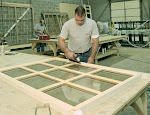I have always enjoyed the play, “Death of a Salesman”. Maybe it’s because I remember meeting the
playwright Arthur Miller when he spoke at my high school on the subject of
McCarthyism back in 1979. Or maybe I’m
just a sucker for the cathartic effects of watching a drama about a life that
remained stagnant while the rest of the world changed. As I reflect upon the gist of the play,
however, it is amazing how pertinent the play’s theme is in today’s business
climate.
Over the past 20 years, the role of the salesman has changed
dramatically in all industries. In
particular, I have noticed a major transformation in the construction industry where
it is obvious that the sales role has been forever altered. In the past, sales personnel were the key
communicators of new products, technologies, and processes. They were a critical factor in the success of
any company. Unfortunately there has
been a steady devolution occurring that is leaving the traditional salesman in
the unemployment line.
The sales process has been a key element in the construction
industry for decades. As manufacturers
developed new products and technologies, they needed a means to communicate
these developments to the marketplace. Sales
departments educated architects on changes in the industry through sales calls,
architectural presentations, and product binder updates. The floors of AIA and CSI shows teamed with
architects and general contractors, hungry for information on product innovations. Magazines catering to the industry were in
high demand because they featured projects incorporating new technologies. It was an exciting time to be on the front
lines.
So let us take a good look at what has changed over the past
ten years. The industry has consolidated
through attrition and mergers and acquisitions.
Sales departments have succumbed to the hatchet of cost control. Architectural offices have little interest in
sales presentations unless they are connected to continued education
credits. Trade show floors have turned
into ghost towns. Magazines and industry
publications are struggling to stay in business. Many people think these conditions are a
temporary result of the anemic economy.
I would submit that the changes affecting the sales process is due to something
else entirely.
One trend that has contributed to the death of the salesman
as we know it is the commoditization of construction products. Over the past couple decades most
manufacturers have figured out how to copy virtually any product or technology
in the construction industry to the point where there is little difference
between the top competitors. Take a
close look at windows, doors, flooring, lighting, finishes, hardware, and
specialties and you will see only minor differences between the players. For example, the major window manufacturers
use the same glass, wood, hardware, and weather stripping to fabricate their
windows, resulting in a collection of me-too products. The result of commoditization has reduced the
decision making process down to one of price and availability. The salesman is no longer needed to explain
product differentiation.
The growth of the internet as a research tool has also had a
profound effect upon the sales cycle. In
the past, architects and general contractors relied upon salespeople to keep
them informed about new products and developments in the industry. In our current cyber world they can now
access updated product manuals on thousands of websites from all over the
world. There is no sense in wasting time
with a sales call when one can access current product data 24/7. It also doesn’t make sense to attempt to
maintain a product library when this same information is available online in an
updated form. Current versions of
specifications can be accessed online in seconds from virtually any major
manufacturer. You can even tap into
online videos of product demonstrations via YouTube.
The Internet also provides valuable information from users
of products by providing them with a vehicle for sharing their experiences. Social media sites like LinkedIn, Pinterest,
and Facebook are good resources for opinions on the merits of different
products. LinkedIn, in particular,
provides an outstanding forum for professionals to share valuable information
on experiences in the construction industry.
In addition, you can search the Internet for blogs featuring opinions on
thousands of topics related to the industry.
Existing litigation against manufacturers is now public information that
is readily available to anyone. Just
type “class action lawsuit in the window industry” in a Google search to see
what I mean. It’s obvious that the Internet
has replaced the salesman as the primary resource for product information in
the construction industry.
So what is a salesman to do in this new environment where
what worked in the past is no longer valid?
Should you just crawl into a hole and brush up your resume to prepare
yourself for a future as a Wal-Mart greeter?
I don’t think so. I believe that
it is time to redefine the role of sales departments in the construction
industry. You can no longer make a
living carrying the product message of the manufacturer and reciting the
features and benefits of a particular widget.
You must now understand how your products relate to the entire industry
and become more of a consultant than a peddler.
It is essential to have a background in the industry so you can provide
solutions instead of product literature.
A firm grasp of the technical aspects of your product and your competitors’
products is essential. Nobody will give
you the time of day unless you can add value by providing relevant applications
that solve current challenges for the construction team.
The construction industry is moving forward. Are you going to act like Willy Loman and
wait for the economic fog to clear, hoping that things will change back to the
good old days? Or are you going to
embrace the new world where the salesman does much more than just peddle
products? The choice is yours to either
adapt or to become fodder for another heartbreaking drama.






